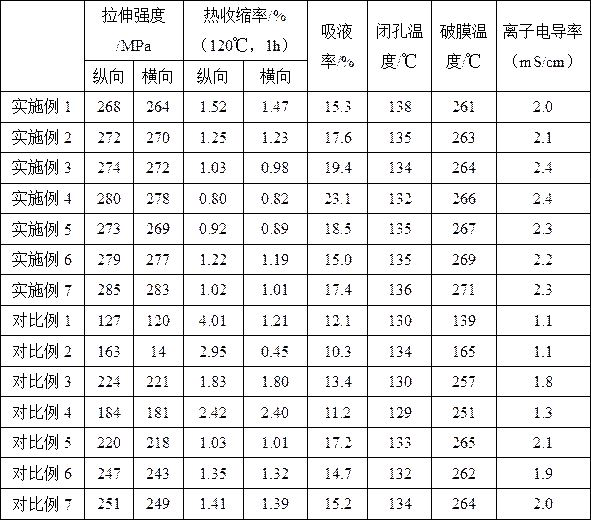Three-layer co-extrusion diaphragm with high heat resistance and high strength and preparation method of three-layer co-extrusion diaphragm
A three-layer co-extrusion, high-strength technology, used in structural parts, electrical components, battery pack parts, etc., can solve the problems of small temperature difference, poor heat resistance, low mechanical strength, etc., to improve mechanical strength and improve safety. properties, and the effect of improving heat resistance
- Summary
- Abstract
- Description
- Claims
- Application Information
AI Technical Summary
Problems solved by technology
Method used
Image
Examples
Embodiment approach
[0041] The initiation temperature of the high-temperature initiator is not higher than the highest temperature in the three-layer co-extrusion process. As a specific embodiment, the high temperature initiator includes 2,3-dimethyl-2,3-diphenylbutane.
[0042] The melt flow rate of the polyethylene is 0.8-4.0 g / 10min, and the melting point is >130°C.
[0043] The weight average molecular weight of the polyethylene glycol is 400-1000.
[0044] A preparation method of the above-mentioned diaphragm, comprising the following steps:
[0045] S1: Mix all the raw materials of the upper layer and the lower layer at 10~33°C at a stirring speed of 100~300r / min for 0.5~1.5h to obtain a surface layer mixture; mix all the raw materials of the middle layer at 10~33°C with a stirring speed of 100~300r / min The stirring speed of / min is mixed for 0.5~1.5h to obtain the intermediate layer mixture;
[0046] S2: After the surface layer mixture and the middle layer mixture are melted at 260~285°...
Embodiment 1
[0051] Through the following steps, a three-layer co-extruded membrane with high heat resistance and high strength is prepared:
[0052] S1: Weigh the following raw materials in parts by weight: 45 parts of polyethylene terephthalate (melt flow rate is 1.2g / 10min, melting point 250°C), 50 parts of polyethylene glycol (weight average molecular weight is 500) , 5 parts of polyethylene glycol methyl ether methacrylate (weight average molecular weight is 730), 0.015 part of 2,3-dimethyl-2,3-diphenylbutane; The stirring speed of / min was mixed for 1 h to obtain the surface layer mixture;
[0053] S2: Weigh the following raw materials in parts by weight: 46 parts of polyethylene (melt flow rate is 2.0g / 10min, melting point 130°C), 50 parts of polyethylene glycol (weight average molecular weight is 500), polyethylene glycol methyl ether 4 parts of methacrylate (weight average molecular weight is 730), 0.012 part of 2,3-dimethyl-2,3-diphenylbutane; the above raw materials were mixed ...
Embodiment 2
[0060] The only difference between this embodiment and Embodiment 1 is that, in step S3, the weight ratio of the inner layer: the middle layer: the outer layer is changed to 15:70:15.
PUM
| Property | Measurement | Unit |
|---|---|---|
| The melt flow rate | aaaaa | aaaaa |
| Melting point | aaaaa | aaaaa |
| The melt flow rate | aaaaa | aaaaa |
Abstract
Description
Claims
Application Information
 Login to View More
Login to View More - R&D
- Intellectual Property
- Life Sciences
- Materials
- Tech Scout
- Unparalleled Data Quality
- Higher Quality Content
- 60% Fewer Hallucinations
Browse by: Latest US Patents, China's latest patents, Technical Efficacy Thesaurus, Application Domain, Technology Topic, Popular Technical Reports.
© 2025 PatSnap. All rights reserved.Legal|Privacy policy|Modern Slavery Act Transparency Statement|Sitemap|About US| Contact US: help@patsnap.com

